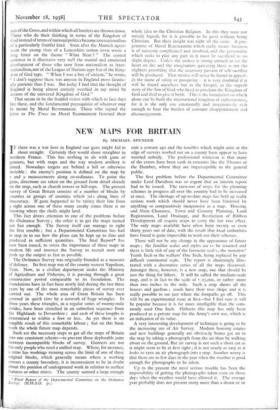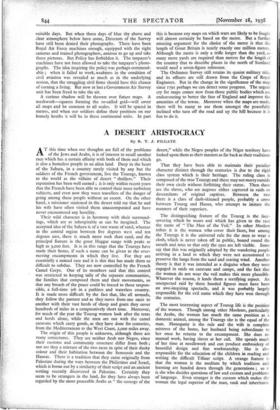NEW MAPS FOR BRITAIN
By MICHAEL SPENDER IF there was a war here in England our guns might fail to shoot straight. Certainly they would shoot straighter in northern France. This has nothing to do with guns or gunners, but with maps and the way modern artillery is aimed. Nowadays targets are behind a hill or otherwise invisible : the enemy's position is defined on the map by x and y measurements along co-ordinates. To point the guns, directions are taken on the ground from detail already on the map, such as church towers or hill-tops. The present survey of Great Britain consists of a number of blocks by counties or groups of counties which jai along lines of inaccuracy. If guns happened to be taking their line from a sight across one of these many creaky zones there is no knowing where the shells might land.
This fact draws attention to one of the problems before the Ordnance Survey ; the other is to get the maps turned out fast enough. The Survey itself can manage to right the first trouble ; but a Departmental Committee has had to step in to see how the plans can be kept up to date and produced in sufficient quantities. The final Report* has now been issued, to stress the importance of these maps in modern life and instruct the Survey to recruit men and push up the output as fast as possible.
The Ordnance Survey was originally founded as a measure of defence. Its first map was of the county nearest Napoleon, Kent. Now, as a civilian department under the Ministry of Agriculture and Fisheries, it is passing through a great constructive period comparable to its foundation. The foundations have in fact been newly laid during the last three years by one of the most remarkable pieces of survey ever carried out. The whole area of Great Britain has been covered in quick time by a network of huge triangles. In three years these triangles, in a regular series of twenty-mile strides, have been stretched in an unbroken sequence from the Highlands to Devonshire ; and each of these lengths is determined to within a foot or less. As yet there is no tangible result of this remarkable labour ; but on this basic work the whole future map depends.
Such are the necessary steps to get all the maps of Britain into one consistent scheme—to prevent those deplorable joins between incompatible- blocks of survey. Gunners are not the only people who need a unified map. Where, for instance, a mine has workings running across the limit of one of these original blocks, which generally means where a working crosses a county boundary, it is inconvenient to be in doubt about the position of underground work in relation to surface features or other mines. The county seemed a large enough * Final Report of the Departmental Committee on the Ordnance Survey. (H.M.S.O. 55.) unit a century ago and the troubles which might arise at the edge of surveys worked out on a county basis appear to have worried nobody. The professional witticism is that many of the errors have been sunk in estuaries like the Thames or the Humber, where they are imperceptible to the general public.
The first problem before the Departmental Committee under Lord Davidson was so urgent that an interim report had to be issued. The turn-out of maps for the planning schemes in progress all over the country had to be increased at once. The shortage of up-to-date maps has held up really serious work which should never have been hindered by anything so comparatively inexpensive as a map. Housing and Slum Clearance, Town and Country Planning, Land Registration, Land Drainage, and Restriction of Ribbon Development all require maps to carry the law into effect. The only maps available have often been twenty or even thirty years out of date, with -the result that local authorities have found it quite impossible to work out their schemes.
There will not be any change in the appearance of future maps ; the familiar scales and styles are to be retained and there is little risk of any of the favourite scales, the motorists' Tenth Inch or the walkers' One Inch, being replaced by any difficult continental scale. The report is charmingly illus- trated with a decorative series of all the maps discussed. Amongst these, however, is a new map, one that should be just the thing for hikers. It will be called the medium-scale map, and is in fact to the scale of 5 /25,000, or rather more than two inches to the mile. Such a map shows all the houses and gardens ; roads have their true shape and it is really possible to see just where the footpaths go off. This will be an experimental issue at first—but I feel sure it will be popular because it is far more intelligible than the com- monly used One Inch. Hitherto this map has only been produced as a private map for the Army's own use, which is an indication of its value.
A very interesting development of technique is going to be the increasing use of Air Survey. Modern housing estates and new buildings generally are obvicuily better got on to the map by taking a photograph from the air than by walking about on the ground. But air survey is not such a short cut as it might seem to be at first sight ; it is not nearly as easy as it looks to turn an air photograph into a map. Another worry is that there are so few days in the year when the weather is good enough for photographs to be taken.
Up to the present the most serious trouble has been the impossibility of getting the photographs taken even on those days when the weather would have allowed it. The average year probably does not present many more than a dozen or so suitable days. But when those days of blue sky above and clear atmosphere below have come, Directors of the Survey have still been denied their photographs. There have been Royal Air Force machines enough, equipped with the right cameras and trained photographers, anxious to go up and take those pictures. But Policy has forbidden it. The taxpayer's machines have not been allowed to take the taxpayer's photo- graphs. The idea inspiring the policy was perhaps commend- able ; when it failed to work, weakness in the condition of civil aviation was revealed as much as in the underlying notion, that the struggling civil firms should have this chance of earning a living. But now at last a Government Air Survey unit has been freed to take the air.
A curious shadow will be thrown over future maps. A meshwork—squares forming the so-called grid—will cover all maps and be common to all scales. It will be spaced in metres, and when our soldiers define their positions on our homely heaths it will be in these continental units. In part this is because any maps on which wars are likely to be fought will almost certainly be based on the metre. But a further amusing argument for the choice of the metre is that the length of Great Britain is nearly exactly one million metres. Although the metre is only a trifle longer than the yard, so many more yards are required than metres for the length of the country that to describe places in the north of Scotland would need a seven-figure reference.
The Ordnance Survey still retains its quaint military title, and its officers are still drawn from the Corps of Royal Engineers. But in the change in the significance of the map since 1791 perhaps we can detect some progress. The urgent cry for maps comes now from those public bodies which are endeavouring to better the face of England and improve the amenities of the towns. Moreover when the maps are made, there will be many to use them amongst the peacefully inclined who turn off the road and up the hill because it is fun to do it.

























































 Previous page
Previous page